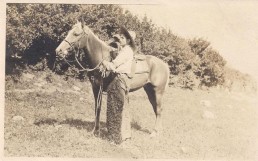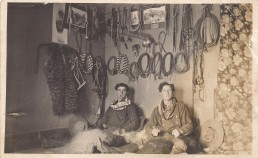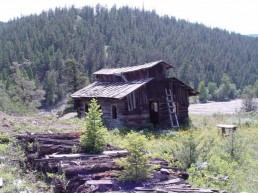Rich History
The Cariboo Chilcotin region has an incredible history from the First Nations who have lived here for over 8000 years to more recent explorations by Simon Fraser and later, the Gold Rush of the 1800’s. We at CCJA are locals with a long family history in the area and enjoy sharing stories from these eras.
First Nations and Early Explorers History
 “Pictograph of a thunderbird”
“Pictograph of a thunderbird”The Cariboo Chilcotin Region consists of three main aboriginal tribes that have been here for thousands of years. The main groups are the Chilcotin’s located on the west side of the Fraser River, Shushwap located east of the Fraser River and Carrier located in the more northern parts of the region. The cultural traditions of these three native tribes mostly involved hunting and gathering techniques as means of survival. Native groups were nomadic following the fish during the spring and summer and the bigger game during the fall.
Today aboriginal people have strong communities and in recent years have been reclaiming their traditional lands and taking on the role of environmental stewards of the lands. Evidence of aboriginal inhabitance is prevalent along the river, on our tours guests get a first hand look at authentic archeological sites.
From the 1700 through 1800’s, native residents were essential to early explorers and European settlers, providing canoes, food, guides, translators and the like. Simon Fraser relied heavily on native guides along his first exploration of the Fraser River. Native guides provided food, clothing and insight to the river and tribes up ahead, with out their assistance he may not have made it out alive to tell his story.
In the early 1800’s, fir trading companies built the first forts in the region in order to trade with local bands. Before these forts were built, natives in the area were bartering pelts with natives on the Coast-who traded them to Europeans arriving by sea. After trading posts were established in the region native people would bring their furs directly to these trading posts.
By the mid 1800’s was the beginning of the gold-rush and European settlement in the region. The fur trading era was coming to an end and the relations between the natives was greatly altered. Many natives still practice their traditional activities on the land today and still can be seen fishing, hunting and gathering.
Western Heritage Connection
 “Leonard Palmantier and his horse”
“Leonard Palmantier and his horse”Your main boat operator is Douglas Green, grandson of Leonard Palmantier, a gun-slinging cowboy from the old west. Born in 1888 Leonard Palmantier rode up from the USA in 1914 to sell a string of horses and returned permanently in 1919. He worked various ranches, then operated his own spread at Riske Creek. Leonard became known as one of the best bareback-saddle bronc riders that ever climbed on a horse, he won and re-won the title of bareback-bronc champion and “best all-round Cowboy of B.C.” In the 1920’s it is said that after winning a championship he made an exhibition ride on one of the meanest bucking horses at the Williams Lake Stampede. This ride was different- Leonard rode facing backwards! He spurred the whole time and stayed with her not only ’til the whistle blew but until she was too tired to buck any more! He was a cowboy who preferred his horse over a car and spent many days roaming the country side taking care of the cattle herds. Leonard Palmantier is listed in the Cowboy Hall of Fame and the family has donated some of his old artifacts to the local Williams Lake Museum.
‘The remarkable story of Jo Curtis Flieger.’
Excerpt from the book “Dreams Come True For Cowboy’s Too!”
“ In the spring of 1921 Leonard Palmantier, Arnie Madden, I and a couple of other fellows were camped out on Williams Creek below the town looking after a bunch of horses we had available for sale or trade. We didn’t have jobs at the time and were trying to pick up a few bucks by trading with Indians or whoever came along.
Our camp was close to the new railway depot, which was then at the end of the Pacific Great Eastern Railway line pushing on north to Prince George. The train came in twice a week from Vancouver, stayed overnight then made the return trip. The train’s arrival was something of a social event as well as commercial because this was in the days before electronic entertainment, and folks showed up whether or not they had somebody to meet or freight to collect. It was something to do.
 “Cylone Smith and Leonard Palmantier with the tack they made by hand.”
“Cylone Smith and Leonard Palmantier with the tack they made by hand.”We led a couple of broncs over to the station and I rode close to the crowd and started a loud spiel about how we had this man eating bronco that was the terror of the West, and I had a crazy partner who wanted to test his mettle by riding the ferocious beast in front of an appreciative audience. Palmantier was a crackerjack rider and his one bronc named “Who’d-A-Thought-It” could really jump around. Leonard whipped around as if he were fighting for his life and put on a great show. Then he got the other bronc and did some bareback riding. He varied his routine by putting a saddle on backwards and riding back-to- front, holding the horse’s tail for a halter shank. Our other fellows whooped and hollered and dashed around to give the scene a whirling atmosphere of intense activity. I worked the crowd with my hat out for contributions, but in that first show, ol’Len was putting on such an exciting display that I almost forgot my business and got to watching him with my mouth open just like everybody else. I recovered, did what I was supposed to do and we made a nice haul. We put on our shows on a regular basis after that and had a good thing going. It even helped our trading business because now people were talking about us and they came around when they had a mind to dicker over a swap or sale. We drew the attention of merchants in Williams Lake and several came in a group to see us. When they drove up, we were apprehensive because we thought they had a complaint of some kind. Instead they said, “Why don’t you guys put on the stampede for us this year? Have some bronc riding and rodeo stuff besides the races we usually have. We readily agreed. A “stampede” is what Canadians call a rodeo, at least some of the time. We went to look at the rodeo grounds where the stampede would be held. The setting was a natural amphitheater, like a saucer, with Cougar Mountain rising beside it. “It was a start of bigger things to come”
Gold Rush History
The Gold Rush Trail began with the discovery of gold along the Fraser River in the Cariboo Region when the Hudson’s Bay Company shipped 800 ounces of gold to the Federal Mint in San Francisco on the steamship Otter in February 1858. The rumour of a steamship with gold had men and women heading north in search of riches. More than 30,000 prospectors sailed north during the summer of 1858 and worked their way up the Fraser River following its tributaries. The River Trail was a main route for travel in the colonial era, running northwards along the Fraser River from present day Lillooet to points beyond. Less celebrated than its wagon-road contemporaries, the Old Cariboo Road, the River Trail (also known as the “Mule Trail”) was the choice for most prospectors and travelers heading north from Lillooet who could either not afford the tolls of the Old Cariboo Road, or had no need of it as the River Trail sufficed for foot-travel or horse travel with small pack trains. Water was in short supply on this route, which is semi-desert for most of its length as far north as what is now Williams Lake, and the route was very rugged, but was favored due to its lower elevation and more temperate climate than the official and more-documented routes eastward over the plateaus.
 “Old cabin along the Fraser”
“Old cabin along the Fraser”One visitor to then Upper Fountains, a staging ground for wagon trains 10 miles upstream from Lillooet, commented that there were few travelers on the wagon road itself, but that a steady line of men and some horses could be seen threading the difficult valley trail in the canyon-bottom below, “like a line of ants”. Parts of the “Mule Trail” can still be seen from the river.
In some areas along the Fraser River, the old gold mining claims and remnants of old mining cabins of that era still remain. We stop to visit some of these sites while taking guests out on the river.

